Understanding and Melting Crystallized Honey
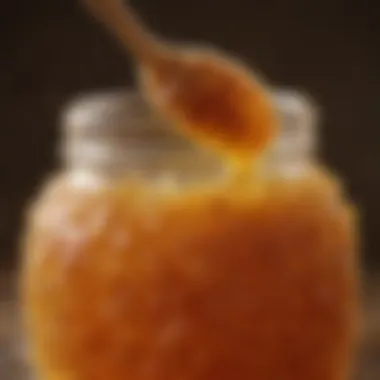

Intro
Crystallized honey is a fascinating and often misunderstood natural product. Many people mistakenly believe that crystallization signifies spoilage, but in truth, it’s a normal process that can occur due to various factors, including temperature and the floral source of the honey. Understanding the science behind this phenomenon not only helps us appreciate honey’s unique qualities but also empowers us to restore it to its original liquid state without compromising its flavor or health benefits.
When honey crystallizes, it typically seeks to revert to a solid form, a characteristic that unvarnished honey enthusiasts often value for its spreadability and robustness. This process, however, can be easily reversed, allowing honey connoisseurs to enjoy honey in its liquid state. By learning about the effective methods for melting crystallized honey, as well as tips for preventing future crystallization, one can savor the sweet nectar in all its forms.
In the upcoming sections, we will break down the steps for melting crystallized honey, explore the chemistry of its crystallization, and address common myths surrounding this divine syrup. Let's delve into the heart of honey, understand its properties, and ensure you get the best out of your jar.
Understanding Honey Crystallization
When we talk about crystallized honey, it’s more than just a phase in its life. This natural occurrence is a key aspect of honey to grasp fully. Knowing why it happens helps everyone, especially those who love their honey, understand its properties better. Whether you’re a home cook or someone just looking to appreciate honey more, realizing the ins and outs of crystallization adds value to your honey experience.
Essentially, honey crystallization occurs when the sugars in honey form bonds and create solid particles. This doesn’t mean it’s gone bad; in fact, it’s a sign of purity and a package of raw goodness. Recognizing how this process works can enhance your appreciation of honey. It’s like knowing the story behind a painting. Every jar has a tale to tell, and understanding crystallization is part of that narrative.
What Causes Honey to Crystalize
Crystallization in honey is primarily driven by several natural factors. When honey is harvested, it’s mostly in a liquid state, but as time passes, the process of crystallization starts. High glucose levels together with low moisture lead to this phenomenon. The chemical composition of honey is very much responsible for how fast this happens. Depending on the flower sources, some honeys are simply more predisposed to crystallization.
Factors Influencing Crystallization
Temperature
Temperature plays a huge role when it comes to honey crystallization. When the temperature drops, or sometimes even when it varies a lot, honey tends to crystallize more rapidly. For example, if kept in a cooler space below about 50 degrees Fahrenheit, the likelihood of crystallization shoots up.
One important aspect to mention is that you want to avoid those colder spots. Keeping honey at a steady, warm temperature helps maintain its liquid form. You’re buying time before it turns into that solid texture. Moreover, if you’re thinking about melting it later, this characteristic of temperature can dictate your experience. Too high, and you may spoil its flavor; too low, and you might end up with a crystallized mound.
Humidity
Humidity also influences honey's crystallization. It sounds simple, but the moisture in the air can have a significant impact on your honey bottle. If you live in a humid area, the water might seep into the honey, boosting the chances of fermentation rather than crystallization.
Generally, honey prefers a drier environment to remain stable. Too much added moisture can alter its properties and lead to inconsistencies. Remember, while honey often benefits from lower humidity, you still need to keep it sealed tight. That water vapor sneaks in quicker than you think. In this article, understanding this interplay can prove beneficial in maintaining the quality of your honey.
Sugar Composition
The natural composition of sugar in honey also plays a critical role. Different types of honey have various sugar content, primarily glucose and fructose. Honeys that have higher levels of glucose will crystallize faster. This is like comparing two friends who like to stick together; some just tend to bond more tightly.
The breakdown of sugar composition helps us understand each variety of honey and how it reacts. Picking a honey with lower glucose will give you a longer shelf life before facing the risk of crystallization. So if you prefer your honey to stay liquid longer, it’s worth paying attention to what flowers produced it. The sweet spot of balance in sugar composition keeps everything in harmony.
The Role of Pollen and Other Particles
Crystallization isn't just about sugars and temperatures; it can also be sparked by pollen and other particles. Honey often contains tiny bits of pollen and other organic materials that act as nuclei for crystallization. These particles, while they often add to the character of honey, can initiate the process when honey is stored for a long period. Therefore, when enjoying honey, especially the raw type, these particulates might seem like a bother but are actually a normal component of the honey's natural state. The presence of these fine particles signifies quality, though they also can lead to varying degrees of crystallization.
Overall, understanding crystallization doesn’t stop at seeing your honey go solid. By delving deeper into why it crystallizes and what factors influence it, you’re not just learning. You’re enriching your honey experience, making it more enjoyable when you pour that golden delight into your favorite dish or beverage.
The Chemistry Behind Honey
Understanding the chemistry of honey serves as a foundation for grasping the processes of crystallization and melting. Honey is not just a sweetener; its chemical composition directly influences how it behaves when subjected to temperature changes. The intricate interplay of its sugars, water content, minerals, and enzymes paints a comprehensive portrait of this natural substance and is critical for anyone interested in maintaining honey's quality.
Composition of Honey
Honey's unique properties stem from its composition, primarily involving sugars, water content, and various minerals and enzymes. Each component plays a vital role in its crystallization behavior and melting properties.
Sugars
Sugars are the star players in honey's composition. Predominantly, honey is made up of fructose and glucose, accounting for about 95% of its sugar content. The relative proportions of these sugars affect not only sweetness but also how honey crystallizes. Fructose, being more hygroscopic, retains moisture better, while glucose tends to crystallize faster. This dichotomy can lead to varied textures and flavors depending on the honey type. The high sugar concentration makes it a favorite among many, as it can impart a rich sweetness without the need for extensive processing.
Water Content
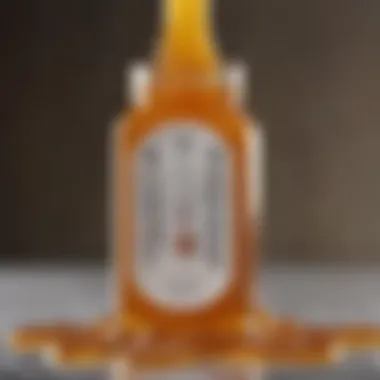
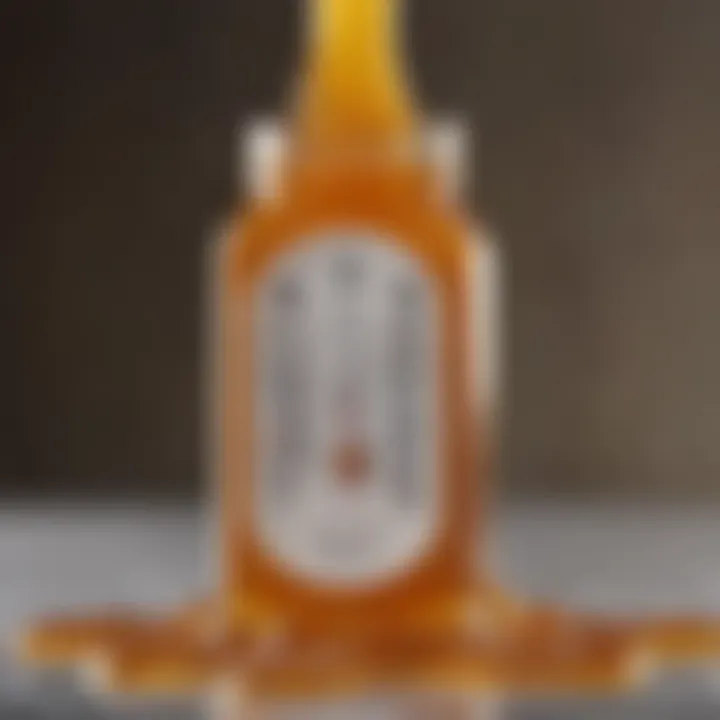
Water content is another pivotal aspect. In a typical jar of honey, you'll find about 17-20% water. This quantity is essential for maintaining the honey's fluidity. Honey with higher water content is more prone to fermentation, making it less desirable for long-term storage. Properly managing the water levels can significantly affect not just crystallization rates but also overall flavor profiles. Honey's water content also influences its viscosity; with lower water content, honey becomes thicker and mellower in flavor, adding a distinct character to culinary applications.
Minerals and Enzymes
Minerals and enzymes contribute significantly to honey's health benefits and functional properties. Minerals such as calcium, potassium, and magnesium not only provide essential nutrients but also impact the crystallization process. They offer a unique quality and enhance the nutritional value. Enzymes, particularly diastase, play a crucial role in breaking down sugars during honey production, leading to variations in taste and texture. The presence of these components can be advantageous for those looking to enjoy honey beyond its sweetness, as they add layers of flavor and health benefits that can truly distinguish one honey from another.
How Sugar Crystallizes
Sugar crystallizes due to a process of supersaturation. As honey cools or loses moisture, it becomes supersaturated with glucose, leading to the formation of crystals. The concentration of sugars directly influences how quickly this process occurs. Various factors such as temperature, humidity, and storage conditions can further accelerate or delay crystallization. Knowing how sugar crystallizes can help one to manipulate these factors effectively, thereby allowing for better management of crystallized honey and its melting process.
Techniques for Melting Crystallized Honey
Melting crystallized honey can be a bit of a dance—one wrong step, and you could end up with a scorched mess rather than that golden nectar you adore. Learning the right techniques is paramount, as using improper methods can diminish its flavor and nutritional quality. In this section, we’ll be digging into various methods, highlighting the crucial elements, benefits, and considerations for effectively melting crystallized honey.
Using Warm Water Baths
Warm water baths stand out as a gentle, time-honored technique. This approach is particularly popular and favored, not just among casual honey enthusiasts but also among culinary experts. By surrounding the jar of honey with a warm environment, you're ensuring a slow and safe melting process that minimizes the risk of overheating.
Ideal Temperature Range
When it comes to the ideal temperature range for melting honey, around 100°F to 110°F (38°C to 43°C) is where it's at. This specific warmth is hot enough to dissolve the sugar crystals but cool enough to preserve honey's essential enzymes and flavors. The beauty of this temperature range lies in its balance—it’s effective yet gentle, allowing honey to retain its sweet charm. Too hot? You risk caramelizing the sugars, turning your golden treat into something more akin to syrup, losing the unique qualities that make honey so special.
- Key Characteristics of Ideal Temperature Range:
- Advantages:
- Disadvantages:
- Dissolves crystals effectively.
- Maintains honey's natural properties.
- Prevents unwanted texture changes.
- Retains flavor and nutritional value.
- Simple and accessible method.
- Requires patience as the melting process is gradual.
Duration of Melting
The duration of melting honey in warm water can fluctuate based on how crystallized it is, but typically, you should plan for roughly 20 to 30 minutes. This slow melt is crucial not only for protecting the honey's integrity but also for ensuring that it transforms back into a smooth, pourable consistency.
What makes this duration significant is that it allows you to keep a close eye on the process. It’s not just about melting; it’s about coaxing the sugar crystals into harmony with the liquid. Letting it sit for too long isn’t the way to go as honey can start losing its unique attributes if it remains in heat for an extended period.
- Key Feature of Duration of Melting:
- Advantages:
- Disadvantages:
- Slow and steady wins the race.
- Reduces risk of overheating.
- Allows you the opportunity to monitor progress.
- Takes longer than some alternative methods, like microwaving.
Microwave Method: Pros and Cons
The microwave can be a real time-saver when you're in a pinch. However, it comes with its own set of quirks. It tends to heat unevenly, causing hot spots that may scorch the honey. If you're not careful, you might end up with pockets of hot honey and clumps of still-crystallized parts. While this method can melt honey in a matter of seconds, keeping a close watch and stirring frequently is the key here. Be prepared to stop the microwave every few seconds to stir and check the consistency. This method’s pros include speed and convenience, but the cons can outweigh these benefits if not done right.
Oven Techniques
Using an oven to melt honey can offer more control than a microwave and a faster melt than a warm water bath. Set your oven to a low temperature—around 150°F (65°C)—and be sure to use an oven-safe container. The gentle heat helps to evenly thaw the honey while preserving its qualities. Just remember, like with other methods, too high a temperature can ruin the honey. This method can be quite effective if you're looking to melt larger quantities at once. However, it requires a watchful eye to ensure it doesn’t get too hot.
In each of these methods, knowing when to pull the honey from the heat and how long to let it melt is crucial. So go ahead, embrace the science of heating honey, and restore its luscious texture for all your culinary creations!
Best Practices for Melting Honey
Melting crystallized honey is not just about restoring its smooth texture; it also means preserving its nutritional benefits and delightful flavors. Engaging in melting practices with care ensures that you enjoy the honey as intended, full of its distinct qualities. Here, we’ll discuss several essential practices that can be applied to melt honey effectively while keeping its integrity intact.
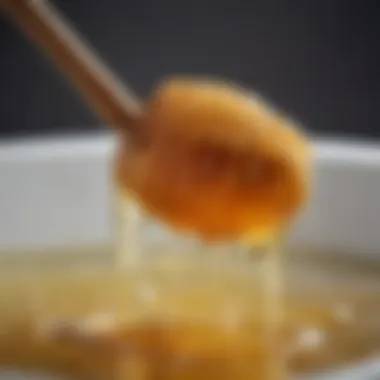
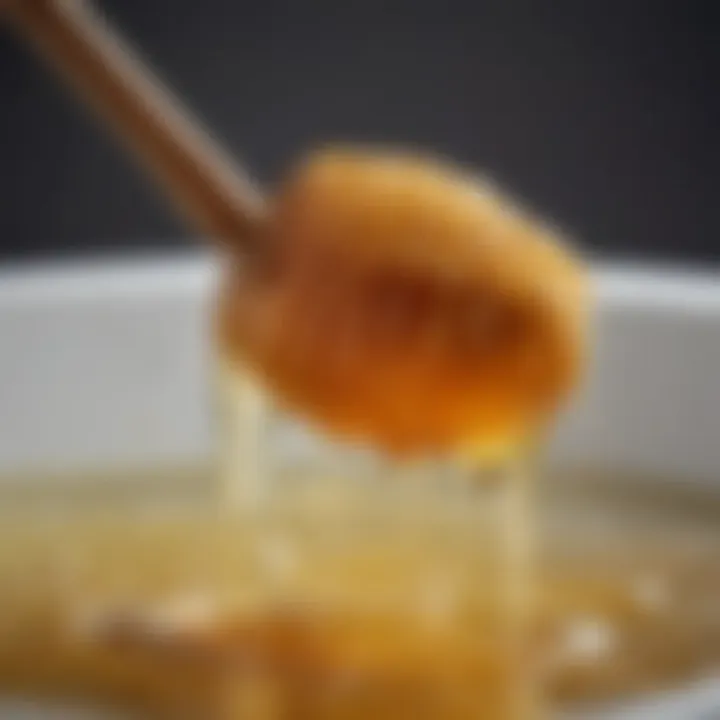
Avoiding Overheating
When it comes to honey, heat can do more harm than good. If you let the temperature rise too high, you risk altering the delicate compounds and flavors that make honey special.
- Ideal Temperature Range: It's advisable to keep your melting temperature between 95°F and 110°F (35°C to 43°C). This range is gentle enough to liquefy the honey without damaging its natural enzymes and nutrients.
- Use a Thermometer: A simple kitchen thermometer can be a handy tool here. This keeps you from second-guessing if the honey’s temperature is just right for a smooth melt.
- Gradual Heating: Whether you're using a warm water bath or the microwave, raise the temperature slowly. Sudden temperature spikes can create hot pockets that may scorch the honey.
"A slow melt is always better than a scorched pot."
Storing Melted Honey
Once you have successfully melted your honey, storing it properly is key to maintaining its freshness. Honey can absorb moisture, which can lead to fermentation if not cared for correctly.
- Choose the Right Container: Glass jars or food-safe plastic containers are ideal for storing melted honey. They should have tight seals to keep out air and moisture.
- Cool Before Sealing: Let the honey cool to room temperature before sealing the container. This practice helps avoid condensation forming inside the container.
- Keep in a Dark Place: Light can cause honey to break down over time, diminishing its flavor and nutritional value. Store your honey in a cool, dark cabinet rather than in direct sunlight.
Monitoring for Quality Loss
Even after following the best melting practices, it's prudent to keep an eye on the quality of your honey. Some variations can occur after melting, and knowing what to look for can help ensure your honey stays top-notch.
- Visual Inspection: After melting, check for any changes in color or texture. Quality honey should look clear and radiant.
- Taste Test: Take a small taste. If the flavor seems off, such as being overly sweet or lacking its usual profile, it might indicate something went astray during the melting process. Honey should retain its unique flavor profile.
- Smell Consideration: A good quality honey will have a pleasant aroma. If there's any sign of fermentation (think that sour smell), it's a signal that the honey isn't in tip-top shape anymore.
By adhering to these best practices, you can melt your crystallized honey effectively and enjoy its full gamut of flavors and health benefits. Whether you're using it in cooking, baking, or simply enjoying it straight from the jar, melted honey can still bring sweetness to your palate.
Preventing Future Crystallization
Understanding how to prevent honey from crystallizing in the first place is crucial for anyone who appreciates this sweet, natural product. Crystallization can happen due to a number of reasons, like temperature changes or the honey's composition itself. Once it crystallizes, many people find themselves grappling with how to restore the honey to its liquid form. Preventing future crystallization not only saves time but also maintains the quality and flavor of the honey. If you're an avid honey enthusiast, mitigating crystallization can help ensure that your honey remains in a state that's easy to use and delightful in taste.
Choosing the Right Storage Conditions
The most effective way to prevent honey from crystallizing is by storing it properly. The right storage conditions can make all the difference, so keep these points in mind:
- Temperature: Ideally, honey should be stored in a cool, dark place at a consistent temperature. Extreme fluctuations in temperature are the enemy here. If you've got it sitting on a counter next to a warm stove or in the fridge, you might be asking for trouble. Just a tad warmer than room temperature is considered optimal.
- Containers: Use airtight containers to keep moisture out. Metal and glass are decent choices. If you're using plastic, be sure it's food-grade and avoid exposing it to heat as certain plastics can break down.
- Humidity: Excess humidity can lead to fermentation which isn't good for honey. This makes basements, where humidity levels might be high, a no-go zone for storage.
Understanding Honey Types and Their Tendencies
Different kinds of honey crystallize differently due to their unique compositions. Not all honey is created equal, so it’s worthwhile to explore how various types behave over time.
Raw Vs. Processed
One significant distinction that can affect crystallization tendencies is between raw and processed honey. Raw honey, which is honey in its natural state devoid of heating or filtering, often contains more pollen, which can act as nucleation sites for crystals. This means that if you've got a jar of raw honey, you're probably going to see some crystallization over time. However, raw honey is loaded with enzymes and antioxidants that have health benefits, making it a popular choice among health-conscious individuals.
Conversely, processed honey is heated and filtered, which removes those particles and, generally, creates a syrup that resists crystallization better. But, in doing so, you miss out on some vital nutrients found in raw honey.
Specific Floral Sources
Honey sourced from different floral types has distinct crystallization characteristics. For example, clover honey typically remains liquid longer than wildflower honey, which might crystallize faster. This is due to the sugar composition that varies between the floral sources. Clover honey has a higher percentage of glucose, which promotes crystallization.
On the other hand, buckwheat honey tends to crystallize slower, maintaining its runny consistency. Understanding these tendencies not only gives you insight into your honey but can help you choose varieties that align with your preferences for cooking and baking, ensuring that your honey stays just how you like it—for longer.
Common Misconceptions about Crystallized Honey
Crystallized honey often gets a bad rap. Many people think it’s somehow inferior or spoiled, but that couldn’t be further from the truth. Understanding common misconceptions surrounding crystallization is vital. This clarity not only aids in de-stigmatizing crystallized honey but also helps in appreciating its unique properties and ensuring its proper use in culinary applications.
One prevalent myth is that crystallized honey has lost its nutrients. In reality, crystallization is a natural process that occurs when the sugars in honey bond together. The nutritional content remains largely intact. When honey crystallizes, some may think it has gone bad, but this is not the case. Crystallized honey is still completely safe to consume, and it can even be easier to work with for certain recipes.
Nutritional Considerations
Often, folks are concerned that the crystallized form of honey might have lesser health benefits compared to its liquid state. However, it’s important to recognize that the crystallization of honey doesn’t strip it of its nutritional value. Honey is composed largely of sugars—fructose and glucose—along with an array of vitamins, minerals, and beneficial enzymes.
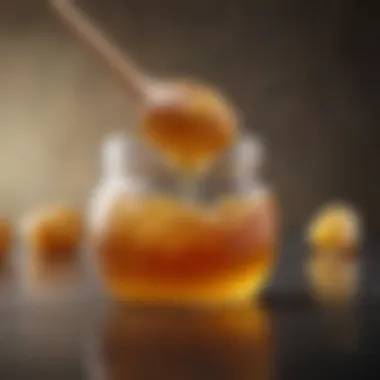
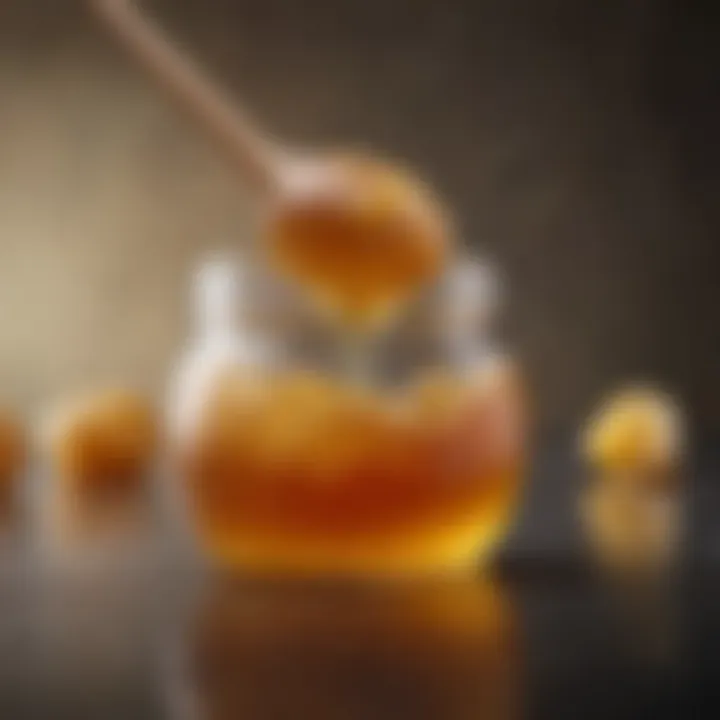
The process of crystallization affects just the physical state, not the impressive array of properties honey can offer. This means that whether it’s crystallized or liquid, honey can still provide various health benefits, such as:
- Antibacterial properties: Honey has a long history as a natural antibacterial agent, and this remains true regardless of its state.
- Antioxidants: Both crystallized and liquid honey contain antioxidants that can help protect the body from free radicals.
- Soothing effects: It still can soothe sore throats and coughs, making it a staple in many homes during flu season.
Impact on Flavor and Aroma
Flavor and aroma are crucial elements in the enjoyment of honey, and misconceptions abound here too. Some people assume that crystallization diminishes these aspects, but, again, that’s an oversimplification. While it’s true that the texture changes, the inherent taste remains well-preserved. In some cases, the crystallized form may even offer a more concentrated flavor.
When honey starts to crystallize, it often develops a thicker texture that can enhance the experience of eating it. As honey crystallizes, the flavor may become more pronounced and less sweet, changing how it interacts with other ingredients in dishes. This is particularly valuable for cooking, where a rich flavor profile can elevate a dish to new heights.
"The shift from liquid to crystal can amplify honey's subtler flavor notes, making it an exciting ingredient even in familiar recipes."
Finally, one shouldn't overlook the importance of aroma. Some varieties of honey—especially those sourced from particular flower nectars—possess distinct and complex aromas. Crystallization does not eliminate these fragrances, though they may become more subtle. Understanding that these changes in perception don’t equate to loss in quality is essential for anyone passionate about exploring honey's diverse profile.
Each jar of crystallized honey carries within it the essence of the flowers that produced it, waiting to be savored, regardless of the form it takes.
Culinary Uses of Melted Honey
Melted honey, unlike its crystallized counterpart, offers an array of culinary possibilities that cater to both savory and sweet applications. Understanding the versatility of melted honey can greatly enhance your cooking and baking endeavors. Whether you're drizzling it over pancakes or incorporating it into marinades, this golden nectar can elevate dishes in ways that few other ingredients can. Not just a sweetener, melted honey adds depth of flavor, a hint of complexity, and a touch of natural goodness that processed sugars simply cannot replicate.
In Baking and Cooking
When it comes to baking, melted honey serves not only as a natural sweetener but also helps in achieving a moist texture in various baked goods. Recipes that rely on this liquid gold—such as muffins, breads, and cookies—benefit immensely, as the honey helps to create a tender crumb and an inviting aroma. Here are a few specific advantages of using melted honey in your baking:
- Moisture Retention: Honey has hygroscopic properties; it attracts water and holds onto it. This characteristic can prevent baked goods from drying out, allowing them to stay fresh longer.
- Flavor Enhancement: The unique floral notes of honey can compliment a multitude of ingredients, fashioning a naturally sweet, yet complex flavor profile. Whether utilizing clover, wildflower, or even lavender honey, each type brings its own signature taste to the table.
- Caramelization: When exposed to heat, melted honey caramelizes beautifully, adding an irresistible touch of color and flavor to your treats.
While melted honey is a terrific ingredient for baking, it’s not without its considerations. Excess heat can modify its flavor, potentially making it taste burnt or overly sweet. Always keep an eye on your oven! Furthermore, when substituting honey for sugar in recipes, the general guideline is to reduce the liquid ingredients slightly to maintain the right balance.
Utilizing Honey in Beverages
Melted honey shines brightly when it comes to beverages, providing balance and sweetness. It's particularly popular in hot drinks, such as teas and coffees, where it dissolves instantly, unlike granulated sugar. Here are several ways to enhance your beverage creations with melted honey:
- Sweetener for Teas and Infusions: Adding melted honey to your cup of herbal or black tea can transform your drinking experience. It melds seamlessly, offering a silky and comforting finish.
- Cocktails and Mixers: Bars and home enthusiasts alike are experimenting with honey in cocktails. Melted honey can serve as a great base, infusing drinks such as whiskey sours or mojitos with its unique sweetness.
- Smoothies and Health Drinks: Incorporating melted honey into your morning smoothies not only adds sweetness but also a wealth of nutrients. It complements fruits like bananas or berries beautifully.
The use of melted honey in beverages extends beyond just sweetening. Its intricate flavors can influence the overall experience, leaving your palate delighted.
"Melted honey can turn an ordinary drink into a luxurious experience, making it a cornerstone for any beverage enthusiast. "
Experimentation is the name of the game when using melted honey in culinary creations. By integrating it thoughtfully, you can discover countless ways to enrich both sweet and savory dishes, making it a staple in your pantry worth melting for.
Final Thoughts
The exploration of crystallized honey, its melting process, and the science behind it is not just an academic exercise—it's a journey into understanding one of nature's sweetest substances. From enthusiasts whipping up their favorite recipes to scientists studying honey's properties, everyone can benefit from knowing how to care for this unique product. When honey crystallizes, it can be frustrating, especially if you're in the middle of creating a culinary masterpiece. Yet, with the techniques discussed in this article, melting crystallized honey becomes an achievable task.
Additionally, this topic highlights the importance of proper storage conditions and understanding the unique characteristics of different types of honey. By taking the time to melt crystallized honey correctly, you're preserving its flavor and nutritional value. This is essential not only for personal enjoyment but also for maintaining the honey's quality if you're selling or gifting it.
Moreover, being educated about the misconceptions and intricacies of honey can elevate your appreciation for this natural wonder. Remember, crystallization is a natural process, and understanding it means embracing honey in all its forms, whether liquid or solid.
"A little knowledge can go a long way when it comes to preserving the essence of honey."
Engaging with honey means indulging in a richer experience, one where you recognize its multifaceted nature. Ultimately, mastering the art of melting honey opens up new avenues in cooking, baking, and creating wonderful beverages.
Recap of Key Points
- Understanding Crystallization: Honey crystallization isn't a flaw; it's a natural process influenced by factors like temperature and sugar composition.
- Techniques for Melting: Several methods can effectively melt crystallized honey without compromising its quality.
- Preserving Quality: After melting, it's vital to store honey properly to prevent future crystallization. Keep it in a cool, dark place to maintain its consistency.
- Common Misconceptions: It’s crucial to clarify that crystallized honey is not spoiled; rather, it is often of higher quality, especially in raw forms.
- Culinary Exploration: Melted honey can be a versatile ingredient in a variety of culinary applications, enhancing both flavor and nutritional content.
- Different types of honey crystallize at varying rates.
- Storage conditions play a crucial role in how quickly honey crystallizes.
- Warm water baths are often recommended for their gentle approach.
- Microwaving can be swift but requires caution to avoid overheating.
Encouragement for Further Exploration
- Types of Honey: Investigate the differences between raw, processed, and mono-floral honeys. Each type carries unique flavors and health benefits.
- Local Honey Sources: Support local beekeepers and discover what regional honey tastes like. Each locale offers diverse floral sources that influence honey's qualities.
- Cooking Techniques: Experiment with honey in various recipes, perhaps using it as a natural sweetener or a glaze for meats and vegetables.
- Nutritional Benefits: Delve into the health aspects of honey, from its antibacterial properties to its role in traditional medicine.
Knowledge about honey shapes your appreciation, allowing you to enjoy it in all its forms. So grab that jar of crystallized honey, and let the melting adventure begin!







